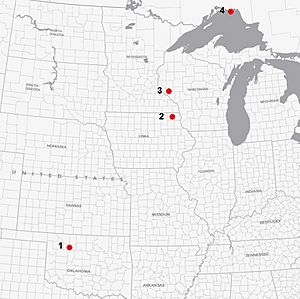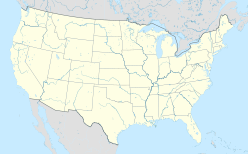Ames crater facts for kids

North American Middle Ordovician impact craters, which may be part of the Ordovician meteor event. Key: 1: Ames crater, 2: Decorah crater, 3: Rock Elm Disturbance, 4: Slate Islands crater
|
|
| Impact crater/structure | |
|---|---|
| Confidence | Confirmed |
| Diameter | 10 mi (16 km) |
| Age | 470 ± 30 Ma Middle Ordovician |
| Exposed | No |
| Drilled | Yes |
| Bolide type | Ordovician meteor event? |
| Location | |
| Coordinates | 36°17′04″N 98°11′38″W / 36.28444°N 98.19389°W |
| Country | United States |
| State | Oklahoma |
| District | Major County |
The Ames crater is a huge hole in the ground made by a meteorite hitting Earth. It's also called an impact crater or an "astrobleme," which means "star wound." This amazing crater is found in Major County, Oklahoma, in the United States. It's about 3 kilometers (2 miles) north of Ames, Oklahoma.
The Ames crater is hidden deep underground. It was not found until 1991. Later, people drilled into the crater and found a lot of oil and natural gas. It is now one of the biggest of six meteor craters in the United States that produce oil.
Contents
What is the Ames Crater?
The Ames crater is about 16 kilometers (10 miles) wide. Scientists believe it formed about 470 million years ago. This was during a time called the Ordovician period. The crater is completely covered by layers of rock and soil. You cannot see it from the surface.
Scientists think the Ames crater might be part of a big event. About 469 million years ago, several meteors may have hit Earth at the same time. This is called the Ordovician meteor event. Other craters from this event might include the Decorah crater in Iowa and the Slate Islands crater in Canada.
How Was the Ames Crater Discovered?
When the meteor hit, this part of Earth was covered by a shallow sea. The space rock was traveling super fast, about 112,654 kilometers per hour (70,000 mph)! When it crashed, it made a huge hole in Earth's crust. The impact also created a slight uplift in the ground.
Over millions of years, the sea returned and laid down many layers of sediment. Other natural movements of Earth's crust tilted the area. Eventually, the sea disappeared, leaving the crater buried and hidden.
The crater was discovered by Rex Olson in 1991. He was looking at a special map made from seismic tests. These tests use sound waves to see what's underground. Olson saw a pattern that looked like a "cow track in the mud." He showed the map to Harold Hamm, the owner of Continental Resources. They both thought the strange pattern looked like an astrobleme, or "star wound."
Before 1991, many geologists did not think that impact sites would have much oil or gas. But the Ames crater proved them wrong!
Oil and Gas from the Crater
The Ames crater is buried under about 2,743 meters (9,000 feet) of sediment. This is why it was not found until 1991. Even though wells had been drilled nearby since the 1960s, none had gone into the crater itself.
Continental Resources decided to drill deep into the crater. They struck oil at about 3,048 meters (10,000 feet) deep. At first, this well produced about 200 barrels of oil each day!
The meteor impact broke up the deep rock layers, like the Arbuckle Dolomite. This created cracks and spaces where oil and natural gas could collect. There were even rumors that the impact might have created diamonds, but no proof was found.
Since 1991, at least 60 wells have been drilled in the Ames crater. About 30 of the first wells are still producing oil and gas today. The Ames crater has produced over 17.4 million barrels of oil. It has also produced 79.5 billion cubic feet of natural gas. This makes it the largest of the six oil-producing astroblemes in the United States.
Images for kids



